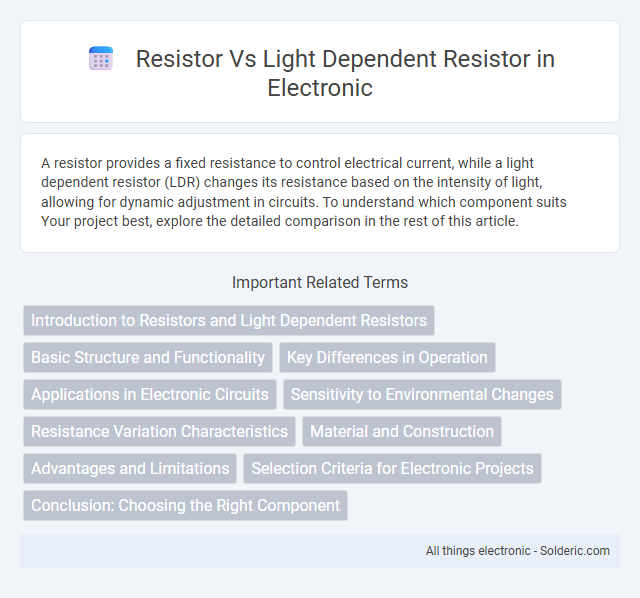A resistor provides a fixed resistance to control electrical current, while a light dependent resistor (LDR) changes its resistance based on the intensity of light, allowing for dynamic adjustment in circuits. To understand which component suits Your project best, explore the detailed comparison in the rest of this article.
Comparison Table
| Feature | Resistor | Light Dependent Resistor (LDR) |
|---|---|---|
| Function | Limits current and drops voltage in circuits | Changes resistance based on light intensity |
| Resistance Type | Fixed or variable resistance | Variable resistance controlled by light |
| Material | Carbon film, metal oxide, wire-wound | Semiconductor materials (cadmium sulfide) |
| Sensitivity | Not sensitive to light | Highly sensitive to ambient light changes |
| Applications | Voltage regulation, current limiting | Light sensing, automatic lighting systems |
| Resistance Range | Ohms to megaohms (fixed) | High resistance in darkness (megaohms), low resistance in bright light (kiloohms) |
| Response Time | Instantaneous | Slower, depends on light intensity changes |
Introduction to Resistors and Light Dependent Resistors
Resistors regulate electric current by providing a fixed resistance, while Light Dependent Resistors (LDRs) vary their resistance based on light intensity, making them ideal for light-sensitive applications. Resistors typically maintain a constant resistance regardless of external conditions, whereas LDRs decrease resistance as ambient light increases. Understanding these differences enables you to select the appropriate component for controlling electrical circuits and sensing light levels efficiently.
Basic Structure and Functionality
A resistor is a passive electronic component made of materials like carbon film or metal oxide that provides a fixed resistance to electric current, controlling voltage and current flow in circuits. A light dependent resistor (LDR), also called a photoresistor, is composed of a semiconductor material whose resistance varies inversely with the intensity of incident light, enabling it to act as a light sensor. While resistors maintain constant resistance regardless of environmental conditions, LDRs dynamically adjust resistance to modulate circuit behavior based on ambient light levels.
Key Differences in Operation
Resistors provide a constant resistance value regardless of external conditions, regulating current flow in electrical circuits. Light Dependent Resistors (LDRs) vary their resistance based on ambient light intensity, decreasing resistance as light exposure increases. This fundamental operational difference makes resistors suitable for fixed voltage division, while LDRs are ideal for light-sensitive applications such as automatic lighting controls and light meters.
Applications in Electronic Circuits
Resistors are fundamental components used to control current and voltage in electronic circuits, making them essential in applications like voltage dividers, current limiters, and signal conditioning. Light dependent resistors (LDRs) vary their resistance based on the intensity of ambient light, making them ideal for automatic lighting controls, light sensors, and alarm systems in electronics. Your project's efficiency can improve significantly by selecting a standard resistor for steady resistance needs or an LDR for adaptive, light-sensitive applications.
Sensitivity to Environmental Changes
Resistors maintain consistent resistance values regardless of environmental factors, ensuring stable performance in circuits. Light dependent resistors (LDRs) exhibit variable resistance that changes significantly with light intensity, making them highly sensitive to ambient light conditions. This environmental sensitivity allows LDRs to be widely used in light sensing and automatic brightness control applications.
Resistance Variation Characteristics
Resistors have a fixed resistance value that remains constant regardless of external conditions, providing predictable performance in electrical circuits. Light dependent resistors (LDRs) exhibit resistance variation based on light intensity; their resistance decreases as ambient light increases, allowing dynamic control of current flow. Your choice between these components depends on whether you need consistent resistance or a sensor responsive to environmental light changes.
Material and Construction
Resistors are typically made from carbon film, metal film, or wire-wound materials, providing a fixed resistance through uniform composition and cylindrical or rectangular shapes. Light dependent resistors (LDRs) utilize semiconductor materials such as cadmium sulfide (CdS) or cadmium selenide (CdSe), featuring a photosensitive surface that changes resistance based on light exposure. The construction of LDRs involves a serpentine or zigzag conductive pattern on a transparent substrate, enabling variable resistance linked directly to the intensity of incident light.
Advantages and Limitations
Resistors provide a constant resistance value, ensuring stable and predictable current flow in electronic circuits, making them ideal for voltage regulation and current limiting. Light Dependent Resistors (LDRs) vary their resistance based on ambient light intensity, offering advantages in light-sensitive applications like automatic lighting controls but suffer from slower response times and less precise resistance compared to fixed resistors. Your choice between these components depends on whether you require consistent resistance or dynamic sensitivity to lighting conditions.
Selection Criteria for Electronic Projects
When selecting between a resistor and a light-dependent resistor (LDR) for electronic projects, consider the specific function and environmental conditions. A standard resistor provides a fixed resistance essential for controlling current in circuits, while an LDR changes resistance based on ambient light intensity, making it ideal for light-sensitive applications. Your choice depends on whether you need a stable resistance or a responsive component that adjusts to lighting variations.
Conclusion: Choosing the Right Component
Resistors provide a fixed resistance value essential for controlling current in circuits, while light dependent resistors (LDRs) vary their resistance based on ambient light levels, making them ideal for light-sensing applications. Your choice depends on whether you need consistent electrical resistance or a component that dynamically responds to changing environmental conditions. Selecting the right component optimizes circuit performance and functionality tailored to specific project requirements.
resistor vs light dependent resistor Infographic

 solderic.com
solderic.com